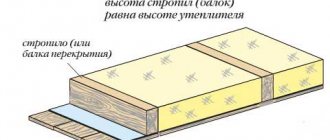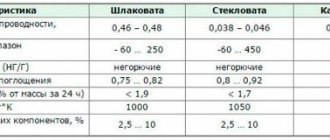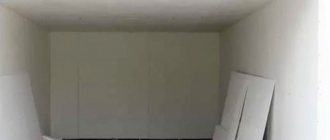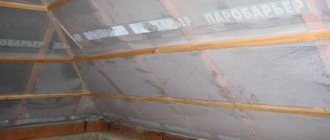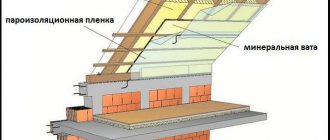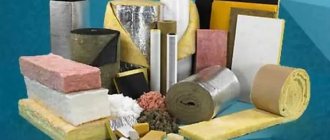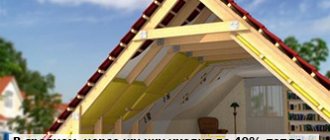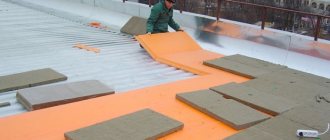To make the attic floor not only warm, but most importantly – problem-free, you need, first of all, to understand the essence of your actions, and not just blindly follow the theory or advice outlined in the video of insulating the attic from the inside with mineral wool with your own hands. Each specific design has its own nuances and features that are important and need to be taken into account. The technology of insulation with fiber materials remains one of the most popular today due to the simple installation and safety of roll insulation.
Is it possible to insulate an attic from the inside with mineral wool?
The first question that you need to decide for yourself is related to the safety of mineral fiber insulation. It’s one thing when you insulate an attic with mineral wool from the outside; this is the most expensive, troublesome and at the same time safe option for thermal insulation of a room. Another question is if the warm layer is located directly on the walls of the attic, and not on the roofing pie. In this case, there is some cause for concern:
- Most insulation materials based on mineral wool, no matter in the form of a roll sheet or in the form of mats, are impregnated with phenol-containing adhesive compositions. The release of phenol has a carcinogenic and toxic effect on the body;
- Basalt, glass or other stone fiber from which the mineral wool layer is pressed is easily destroyed and turns into dust that enters the respiratory system and settles on open areas of the skin.
Important! Advertising often presents the latest mineral wool-based insulation as an absolutely safe and environmentally friendly material that does not generate dust and does not emit phenol.
In fact, in high- and medium-price mineral wool, both parameters are reduced several times compared to old materials, but they are still present. For cheap insulation materials, the emission index and dust emission remain the same as 20 years ago.
It is possible and necessary to build thermal insulation for the attic floor, but only under one condition: the technology for insulating mineral wool from the inside of the attic must provide for complete isolation of the material from penetration into the residential or service areas of the building. You can and should use fiber insulation.
Materials for insulating the attic from the outside
To insulate the attic from the outside, you can use various materials, but whatever material is chosen, it must have the following performance characteristics:
- resistance to mold and moss growth;
- durability;
- maximum thermal insulation;
- environmental friendliness;
- fire safety;
- maintaining performance over time.
The following types of insulation can be identified as relevant for this type of work, since they have all the properties mentioned:
- Glass wool. The material is known to everyone and has a long history. High resistance to fire, low thermal conductivity and an affordable price make this material a fairly acceptable material, but the inconvenience of work significantly increases the time of insulation measures, and in some people it causes allergic reactions associated with the content of glass fibers.
- Minvata. It is a safer and more environmentally friendly option for glass wool. In addition, it is not prone to absorbing moisture and has excellent sound insulation. Therefore, attics insulated with mineral wool are suitable for creating living rooms or libraries (if the house has a high roof).
Thermal insulation material such as polystyrene foam requires special attention. This material comes in two versions, let’s look at them:
- Styrofoam. A classic modification of expanded polystyrene, which consists of 98% weightless granules with an impenetrable shell. They undergo short-term high-temperature sintering, which gives the foam all the necessary qualities. As a result, the granules are pressed together and form a slab of the required size.
- Penoplex (extruded foam). The foamed mass of polystyrene is passed through the head of a special extruder, which leads to the formation of penoplex. In all respects, this material is superior to polystyrene foam, so insulating the attic gable from the outside with penoplex can be said to be the most acceptable option.
Pros and cons of attic insulation with mineral wool
Few people know that a third of household refrigerators have insulation based on a layer of mineral wool, only 15 mm thick. And this fact does not interfere with the safe use of the device for a long period without harm to health.
There are several very important advantages to using mineral wool to insulate an attic:
- Fiber material made from fused rock does not burn; if the wiring in the attic closes, the fireproof insulation layer temporarily blocks the source of fire;
- Mineral wool is one of the few insulating materials that can transmit warm water vapor;
- Durability, with proper installation, insulation can last on the walls from the inside of the attic for at least 40 years;
- The light weight of the insulation allows you to reduce the load on the walls and ceiling of the attic.
For your information! The most important advantage of the material is its very low thermal conductivity, approximately 0.041-0.042 W/m*oC, for comparison, for foam plastic it is 0.037-0.039 W/m*oC.
Another advantage is excellent sound insulation; of all heat insulators, mineral wool-based insulation best absorbs noise from rain, especially if the roof above the attic is covered with metal.
Negative aspects of using mineral wool for the attic
Among the most important disadvantages, in addition to the release of phenol and the formation of dust, one can note a strong tendency to watering. In direct contact with liquid water, mineral wool does not absorb it; the moisture rolls off the insulation surface in drops. But when in contact with cold, steam-saturated air, the insulation absorbs water like a sponge.
If, when installing insulation from the inside of the attic, a layer of mineral wool is exposed to rain or damp autumn fog, then most likely the insulation will have to be replaced. It is not possible to dry the material even after a month's exposure to the sun; it will still remain damp from the inside, and there will be little use from it.
Therefore, when planning your own insulation with mineral wool from the inside of the attic, first of all you will need to take care of insulating the material from moisture in any form.
Insulation of attic floors and walls
Mineral wool must be protected from moisture.
This process is very similar to roof insulation:
- We lay a vapor barrier or a layer of bitumen-impregnated paper on the boards between the rafters, which will keep mineral wool particles from slipping through the support and getting into the air of the lower floors;
- then we line the heat insulator itself in two layers with a total thickness of 15-20 cm;
- If necessary, we nail additional blocks on top to increase the height of the rafters. We place a waterproofing layer on them and cover everything with boards (subfloor).
It is important to note that floor insulation also needs to “breathe”. Therefore, a vent of 3-5 cm is maintained between the top film and the floor, and a gap of 10-20 mm is left between the floor and the wall at two opposite edges of the room. Thus, insulating a country attic from the inside with mineral wool with your own hands will be as effective and durable as possible. Interesting article: “Insulating a bathhouse with mineral wool.”
Also, if possible, it is recommended to lay the vapor barrier overlapping the walls downwards (that is, the ends are lowered along the walls of the lower floor and plastered). This will prevent any steam from penetrating into the mineral wool and damaging it. The walls, if necessary, are insulated in the same way. Only in this case, depending on their density and thickness, the thermal insulation layer is reduced and the external waterproofing film is removed.
In fact, the qualities of single-sided foil-coated reflective insulation as insulation have been over-exaggerated.
In terms of price, insulating a garage with mineral wool is the cheapest. Details here.
How to choose mineral wool for insulating an attic roof
Almost any type of mineral fiber is suitable for laying thermal insulation from the inside of the attic, the main thing is that the material is certified and meets all the requirements for stone wool. If you have the opportunity to choose, it is best to use mineral wool of the middle and upper price segment, such as Rockmin Rockwool, Izover Ursa, TechnoNIKOL Rocklight.
The advantages of such brands of insulation include:
- Minimal release of pili and phenol;
- The presence of surface impregnation, which gives the sheets good flexibility and elasticity.
Such a mat made of mineral wool can be laid in a cell of the sheathing and not worry that the material will settle from inside the wall, and thus a window or a cold bridge will be formed in the attic wall. Mineral wool generates less dust, but still, when laying it from the inside of the attic, you must use protective clothing, gloves and a respirator.
Requirements for materials for insulation
Materials used for attic insulation must have:
Table of comparative characteristics of insulation materials.
- Fire safety. They should not support combustion.
- Perform sound protection functions that prevent the penetration of noise from the outside.
- Vapor permeability function to ensure the necessary microclimate in the attic room.
- Compliance with environmental, sanitary and construction standards.
- Strength and durability.
- Resistant to deformation.
According to the recommendations of many experts, the insulation layer should be 25-30 cm. It is better to arrange a double or triple layer. This method of insulation prevents the appearance of cold bridges. When insulating the attic, we must not forget that the pediment is also a wall of the attic. A wooden gable requires a thicker layer of insulation than brick walls.
Thickness of mineral wool for attic insulation
The parameters of the heat-insulating layer are selected based on information about the climate and maximum temperatures in winter and summer. For example, for a temperate climate, the thickness of the mineral wool laid from the inside of the attic is assumed to be 150 mm; for more southern latitudes, 100 mm will be sufficient. If the frost reaches 25-35°C, then the insulation needs to be increased to 250 mm.
For areas with strong, constantly blowing winds, the thickness of the insulation from inside the attic space is increased by a factor of 1.5. In addition, the thickness of the mineral wool layer is greatly influenced by the layout and size of the attic. For cases where the attic is designed as a room with straight vertical walls, inscribed from the inside into the volume of the attic, 150 mm of insulation will be sufficient; in other cases, the mineral wool layer is increased to 200 mm.
Technology of thermal insulation of the attic from the inside
Let's consider the option of insulating the attic from the inside with mineral wool with your own hands, when the roof has already been built. This method is a little more complicated than with the initial insulation when laying the roof, as it can cause a number of inconveniences. When using mineral wool, it is very important to prevent it from getting wet. Therefore, you need to strictly adhere to the technology in which the insulation cake consists of the following layers:
- waterproofing;
- insulation;
- vapor barrier.
Waterproofing
This insulation layer is a membrane film that does not allow moisture to pass inside. It serves as protection for mineral wool from the direct effects of precipitation that has seeped under the attic floor. The need for it arises when the roof is damaged. Then precipitation that gets inside the attic space accumulates on the film and flows out of its aisle, without contacting the insulation. If water gets on the heat insulator, the cotton wool will absorb it and the stain will spread throughout the entire sector. A wet space on the attic insulation layer will no longer function properly.
The membrane film performs two functions, which are to protect the insulation from moisture penetration and remove the steam located under it. Thus, the water from the outside stops, and the steam from the inside passes unhindered. As a result, even if the mineral wool is saturated with liquid, it will be able to dry out and not constantly remain in this state.
Attic waterproofing works best when laid flat on top of the sheathing and taped at the joints. If the film was not installed during the construction of the roof, this creates problems that will complicate the insulation. Moisture protection must be present. To do this, you will have to remove the ceiling and lay it on the sheathing, since this cannot be done from the inside. The film is installed without tension to allow it to expand and contract freely with temperature fluctuations. The joints between the rolls must be glued with a special compound. If the film was installed initially, then you can proceed to the next stage of insulation.
It is also necessary to ensure that there is sufficient space between the roof and the waterproofing. The gap is needed so that the accumulated moisture on the surface of the film can be dried by the wind.
Insulation
The next stage involves direct insulation of the attic. It will not be difficult to do this with your own hands using ordinary mineral wool. This material is very light and has the necessary properties. In addition, its relatively low cost makes it an ideal solution for insulating an attic on a limited budget. The main advantages of the material:
- ease;
- low thermal conductivity;
- low cost;
- durability;
- ease of installation.
Important!
Before insulating the attic with mineral wool, you need to wear thick clothing, glasses and a respirator, since its dust causes irritation on the skin. Mineral wool is sold in rolls or in the form of cut rectangular mats. Its thickness also varies. For the middle climate zone, it is recommended to install mineral wool in a layer of 200 mm or more. Some manufacturers offer their products that are thicker. This allows you to lay it in just one layer, and not in four, when mineral wool is produced in a 50 mm version.
Experts recommend using multilayer insulation technology, as this allows layers to be adjusted in different directions. So, three layers can be mounted vertically, and one horizontally. This will allow you to close the joint at the joints, which will increase the efficiency of attic insulation.
In order to properly insulate an attic with mineral wool, you need to calculate the amount of materials and their parameters at the procurement stage. Therefore, you should measure the distance from the rafters on which the roof is supported, since the insulation from the inside is laid between them.
The width of the pieces or roll of mineral wool should be 1 cm larger than the internal gap between the boards. This allows you to lay it tightly so that it does not fall out and interfere with work. Thus, when you come to a hardware store, you need to know these parameters in order to select materials of the appropriate size.
The process of laying insulation with your own hands is very simple and consists of placing pieces of mineral wool, adjusted to size, between the rafters from the inside of the attic. This can be easily done with your own hands without outside help, because the material does not need to be glued or nailed. The mineral wool, being a centimeter wider than the space between the rafters, is pressed in and holds perfectly on its own. We must remember that one layer should be laid horizontally. This will take a little time since you will have to cut short pieces, but it is still necessary.
Vapor barrier
This is the final inner layer of the insulation cake. Its function is to prevent the passage of moisture from the attic to the mineral wool. This layer consists of a vapor barrier film, which has a complex structure, so its installation must be carried out in compliance with the technology indicated on the packaging.
The film is stapled from the inside of the attic, with the smooth side facing the insulation. Its joints are tightly glued together using tape. This allows you to achieve maximum density of adhesion of the materials to each other without the possibility of penetration of air containing steam.
Important! Vapor barrier film has different performance indicators for each side. Therefore, when installing it, you need maximum attention so as not to confuse it, which will lead to the opposite result of its operation and a decrease in the efficiency of insulation.
Vapor barrier prevents the formation of dew point on the surface of mineral wool. Since it is colder on one side of the insulation and hotter on the other, the formation of condensation from moist air will be inevitable. The film does not allow air containing moisture to come into contact with the surface of the mineral wool. The easiest way to secure it with your own hands is with double-sided tape glued to the rafters.
Roofing pie composition
The structure of the roof slopes, which are also the walls of the attic, is not much different from a standard insulated roof. Almost always, when planning the arrangement of an attic, craftsmen leave the roof slope bare from the inside. Only the sheathing and rafters can be seen. This approach is not mandatory, but it significantly simplifies the work and makes it possible, if necessary, to change the layout of the attic from the inside.
Option with a residential attic
The simplest way to transform the under-roof space into an attic is to convert the attic into a living space. In order for a room located inside the roof to be considered an attic, the walls of the superstructure must be a continuation of the brickwork of the first floor. But more often than not, such standards are neglected and a room with sloping walls is built. In this case, the attic is insulated from the inside, like a regular roof.
Most people prefer to simply convert the attic into an attic from the inside, install false walls, insulate it with mineral wool and line it with plasterboard.
The insulation device of this option is shown in the diagram below.
Structurally, the insulation of the walls and roof from inside the attic room is constructed as follows:
- A vapor barrier membrane is laid on the roof counter-lattice;
- Two layers of mineral wool insulation are laid with a slight indentation from the film;
- On top of the rafters there are horizontal wooden slats, on which the last layer 50 mm thick is laid;
- The final stage is another layer of film vapor barrier.
To prevent the film from being torn off by air pressure, slats are sewn on the inside of the attic walls; they can be used to assemble a metal profile for laying drywall.
Insulation of the attic in the classic version differs only in that both layers of vapor barrier, both the one laid under the roofing and the film from the inside of the attic, are laid and continued to the level of the ceiling.
What to pay attention to
When converting an attic into something like an attic floor, a situation arises when part of the under-roof space ends up outside the attic space. A cavity is formed between the roof slope and the vertical wall from the inside, the dimensions of which can reach 1-2 m in width. This section of the ceiling also needs to be insulated and covered with a vapor barrier film. The same applies to the space from inside the roof, located above the attic ceiling.
Sometimes developers, when installing a small attic room in a large attic, forget about protecting the roofing. One of these options for insulating an attic from the inside with mineral wool is shown in the video
In order to prevent the insulation of the walls of the future room from becoming damp, it is necessary to cover not only the mineral wool layer with a vapor barrier, but also the sheathing of the roof slope. It is even better to lay an additional layer of polystyrene foam insulation from the inside of the roof. Warm water vapor breaking through the ceiling and walls of the attic will be easily removed by attic ventilation. If this is not done, the layer of mineral wool on the walls of the room may become damp and even freeze.
Work order
To insulate the attic from the inside with your own hands, you should adhere to the following recommendations:
- First, check the evenness of the rafter legs. This can be done using a rule - a metal strip that is applied to the beams.
- Measure the distance between the rafters. For ease of working with mineral wool, at the roof design stage, the pitch of the rafters should be taken so that the clear distance between them is 580 or 1180 mm. This will allow the use of slabs with a standard width of 600 mm without cutting. It will be easier to work with a step of 580 mm, since here you only need to lay one slab in width, therefore, its fastening is simplified. A margin of 20 mm is needed to ensure that the slabs are held during installation due to frictional forces without additional fasteners. In addition, installation with a spacer allows you to avoid the occurrence of gaps and cracks between beams and insulation slabs.
Laying slabs between rafters - Insulation work begins only after the waterproofing and roofing have already been installed. This is necessary to protect the material.
- If the distance between the rafters does not correspond to the above values, then cut the thermal insulation slabs. In this case, the above-mentioned margin of 20 mm is provided (the width of the thermal insulation element must be greater than the clear distance between the rafters).
- In order to install mineral wool in the design position, it is slightly compressed and mounted between the load-bearing roof structures. At the same time, the absence of creases and wrinkles on the surface of the insulation is monitored. It is important to control the quality of the fit of the material in the places where roof windows are installed. To do this, you will need to cut out several non-standard insulation elements and install them along the frame in the same way as for the entire roof plane.
It is necessary to carefully seal the joints - Insulating the attic from the inside includes not only insulating the roof, but also the walls (if it is not done from the outside on the previous floors). To insulate the gables or external walls on which the slopes rest, you need to build a frame. The distance between the racks is taken based on the recommendations in paragraph 2. It is important to take into account that for walls and roofs the requirements for heating engineering differ, so you will need to perform two separate calculations for thickness (when using the program this will not greatly increase the time costs).
- After installing the slabs, insulating the attic involves eliminating all pathways for cold penetration. To do this, use sealant or polyurethane foam and fill the joints between the outer rafters and the wall and other weak spots.
- To prevent the insulation from getting wet from steam from a warm room, install a vapor barrier film. Most often, polyethylene is used as it, but a more modern solution would be the use of vapor barrier membranes. The material is smoothed out and attached to the rafters using a construction stapler. The staple spacing is 15-20 cm. The film is mounted with an overlap of 10-15 cm. After fastening, the joints of the film strips are glued with tape, which will provide additional reliability for the protection of the insulation. After the vapor barrier film, the bottom sheathing is fixed, which will hold the mineral wool in the designed position and become the basis for the ceiling structure.
Vapor barrier will prevent the insulation from getting wet
The insulation of the attic is now complete. All that remains is to finish covering the ceiling. Most often, installation of plasterboard sheets on a metal profile is used. The profile is fixed perpendicular to the rafter legs with self-tapping screws in increments of no more than 50 cm. Next, sheathing sheets are attached to it. After securing the plasterboard base, you can begin finishing the ceiling.
Such work can be done alone, but it is better if there are two builders. This will increase the accuracy of the work, since one person can hold the element and check that its position is in accordance with the design, while another person can perform fastening. Insulating an attic with mineral wool will not take much time and will not cause any particular difficulties in the process if you follow the recommendations.
Preparing the attic roof for insulation with mineral wool
Most of the preparatory work consists of performing two procedures:
- Laying a vapor barrier membrane on the walls with fixation by horizontal slats;
- The second step is to install a wooden frame made of timber onto the walls of the attic.
It is clear that in the case where the roof slope will serve as the wall of the attic space, a roof counter-lattice can be used to lay the mineral wool. In any case, there should be a vapor barrier between the roofing and the insulation.
How to prepare an attic for insulation with mineral wool
Correctly carried out preparatory measures will help to avoid poor-quality thermal insulation in the room:
- Inspect the roof truss system to identify rotten or cracked elements. If there are any, then it is recommended to completely replace them with new ones. There should be no damp, rotten or moldy elements.
- Treat the wooden structure with an antiseptic compound and prime it. Such simple techniques will reliably protect wood not only from the harmful effects of moisture, but also from pathogenic microorganisms. After this, all wooden elements must be thoroughly dried. If you follow the manufacturer's instructions, there will be no difficulties with the use of protective impregnation.
- If the thickness of the rafters is insufficient, an “extension” should be performed. This implies additional beams and boards nailed to them. The thickness of the rafters should correspond to the thickness of the selected heat insulator - this is convenient during installation, and also more reliable for the stability of the entire system.
Advice! The formation of cold bridges will be eliminated by installing sheathing that is installed under the rafters.
How to properly insulate an attic with mineral wool with your own hands
Few people like an attic room with sloping walls. Despite the certain stylishness and effectiveness of this layout, in practice such placement turns out to be not very convenient. Therefore, they always try to make an attic with vertical walls, even with a slight reduction in space.
Insulation of the inclined part of the wall, which coincides with the roof slope, is carried out according to the classic roofing pie scheme, while problems occur with vertical sections.
Insulation of attic walls from the inside with mineral wool
After the vapor barrier has been stretched, and a frame of vertical slats has already been assembled on the wall, they proceed to laying the mineral wool. First of all, individual sections or sheets are cut from a roll of insulation.
Important! The size of a separate sheet should be 1 cm less than the distance between the vertical slats.
Many mineral wool manufacturers produce insulation in the form of ready-made mats 61 cm wide. To install it on the walls, just unpack the block and place the finished pieces of mineral wool in the window frames. It is clear that in this case the distance between the wooden posts should be no more than 60 cm.
The next layer of insulation is laid with the seams staggered. If the thickness of the timber from which the frame is assembled is 100 mm, then two layers of 50 mm thick can be laid simultaneously.
The next step is to fill the frame filled with insulation with additional horizontal slats in increments of 60 cm.
The last, third layer of mineral wool is laid overlapping the remaining seams between the vertical slats and the laid mats. The last step is to stretch the second layer of vapor barrier from inside the room.
Important! The edges of the film should be laid with an overlap of 20 cm on double-sided tape.
Insulating the attic ceiling with mineral wool
Laying insulation on a ceiling frame is no different from performing work on vertical walls. The only nuance is the fixation of the mineral wool roll sheet on the ceiling sheathing.
If on a vertical frame the mats were held in place by pushing forces, then for the ceiling this is clearly not enough. Therefore, most often the installation is carried out either on an additional sheathing or using lacing made of polypropylene rope. In this case, insulation of unlimited thickness can be laid.
Insulating the attic floor from the inside with mineral wool
To form a frame for laying thermal insulation, first of all, it is necessary to lay the subfloor. This can be a screed or a sublayer filled with OSB boards. The material does not matter, the main thing is that the base is perfectly flat.
Next, a galvanized steel mounting profile is sewn onto the slabs. Logs can also be made from timber, but it will take much more time to lay the future attic floor from the inside. A vapor barrier film is laid on the supporting profiles and the free space is filled with mineral wool strips. Next, another layer of film is laid, and a floor covering made of plywood or GSP is installed.
Insulation of the attic gable with mineral wool
Installation of insulation on gable walls differs only in the installation of an additional air gap between the material with which the gable is sewn and the waterproofing film. This is followed by lathing, vapor barrier and a layer of mineral wool. The thickness of the insulation for the gable is usually chosen to be the same as that of the roofing pie.
Roof insulation with mineral wool
This area is insulated first, not only for purely logical reasons, but also in order to slightly delay the insulation of the floor and walls. This is done in order to allow the wood to dry for as long as possible. Otherwise, the moisture it releases may settle on the insulation and slightly weaken its inert properties.
The thickness of mineral wool for attic insulation is 20-25 cm.
You need to start the insulation process from the outside (the case when the house is just being built). A vapor barrier is laid on the pre-prepared sheathing (boards perpendicular to the rafters, nailed on the inside) and mineral wool blocks are laid out. The thickness of the mineral wool for insulating the attic should be 20-25 cm. If the thickness of the rafter beams is insufficient, you can do the following:
- or nail 50 mm blocks parallel to the support (on the rafters themselves) and lay stone wool in two layers, one on top of the other;
- or make a counter-lattice from 60-120 mm bars/boards (this way we will leave a gap between the mineral wool and the external insulation), after which we line the second layer of insulation perpendicular to the inner one;
The second option is good because with its help we get rid of the so-called cold bridges and improve the heat transfer performance of the house. The same technique can be used when insulating the attic from the inside with mineral wool. After laying out the thermal insulation, a hydro-windproofing film is spread on the outside of the rafters (or blocks, in this case). Also read: “Waterproofing materials for roofing.”
The necessity and peculiarity of using this material is that it allows wet vapors to pass through only one direction (outside) and keeps moisture from a leaking roof from getting inside. The insulation must be secured with screws or a construction stapler, leaving very little sagging (so that the layer does not deform and lose its qualities as a result of tension during temperature changes).
When connecting sections of waterproofing, maintain sufficient overlap (about 15 cm), which will protect against leaks and the formation of gaps that release heat to the outside.
We block the cold bridges.
The intersecting layers are secured together with special double-sided adhesive tape or reliable construction tape. You can make a slight bend on the outer rafters and once again secure the edges of the film with stapler staples. Then a counter-lattice is applied to the waterproofing layer, creating a gap between the roof and the insulation layer.
The approximate thickness of this layer should be 5 centimeters. Its function is ventilation and removal of moisture accumulated under the tiles. It is important that at the highest point of the roof (ridge) a small cavity is left, not filled with insulation or timber. Through it, moist air will leave the building, passing from under the edge of the roof up and out again.
If the house has already been built, when insulating the attic from the inside with mineral wool, the insulation is fixed using a construction stapler (on the side surfaces of the rafters). There is also a five-centimeter gap between the film and the roof cladding for ventilation. Afterwards, with a margin of width of 10-15 mm (relative to the distance between the rafters), the thermal insulation is cut and lined.
Insulating the attic with mineral wool from the inside ends with attaching a vapor barrier layer to the inside of the rafters (or counter-lattice), which will not allow the mineral wool to become saturated with moisture. Another row of beams is fixed on top, on which chipboard panels or the interior decoration of the room itself will be held.
Before insulating a garage with your own hands, you need to choose thermal insulation. There are many options, but it’s easier to work with foam plastic or mineral wool.
You will find a method for insulating walls inside a garage in this article.
Tips and tricks
The most common mistake made when insulating an attic is improper storage of mineral fiber. Mineral wool cannot be stored without packaging or in the open air. As soon as the material is purchased, it is transported to the location of the future attic and tightly covered with plastic film.
Packs with insulation are unpacked immediately before installation, and upon completion of work they must be covered with a vapor barrier. Joints and seams must be sealed with tape, otherwise dust from the mineral fiber will very quickly spread throughout the attic room.
Mineral wool: definition and manufacturing technology
Among the existing methods of insulating an attic from the inside, mineral wool comes first as an economically advantageous and technically convenient material. Its price is significantly lower than other insulation materials, and installation is easy and simple.
Mineral wool is a reliable insulation material
Mineral wool is fiber obtained from the melt of volcanic rocks, waste from glass and blast furnace production. Depending on the base, insulation is divided into basalt, slag or glass wool.
Types of mineral wool insulation
To obtain it, the same technology is used:
- Glass, molten rock or blast furnace slag is loaded into a shaft-type furnace.
- At temperatures above 1500ºС they are heated to a liquid state. Fibers are obtained directly by blowing or centrifugal method. They make up the structure of the material.
- The fibers are bonded with phenol-formaldehyde resins followed by polymerization.
- Heat treatment.
- Package.
Technological scheme for producing mineral wool
Mineral wool is hygroscopic, and with prolonged contact with water it loses its thermal insulation properties. To prevent moisture from entering, the material is sealed in plastic film.
Choice of insulation
When thinking about how to properly insulate an attic roof, you need to carefully choose the insulation. As a rule, mineral wool is used, in particular basalt or sprayed insulation, for example Polinor. Roof insulation with foam plastic is usually not done, except for the gable. But, usually the construction of an attic floor is made of wood, including the pediment, so it would be more logical to use mineral wool in all places, including outside.
The main factors influencing which insulation to use for an attic roof are:
- Coefficient of thermal conductivity;
- Flammability;
- Hydrophilicity;
- Safety.
Let's look at these factors in a little more detail, and based on them we will choose the best insulation for the attic floor.
Coefficient of thermal conductivity. The amount of heat that passes through a material per unit time. For brick, this figure is 0.6 W/m*K. For mineral wool and foam plastic it is approximately the same and equal to 0.03 - 0.04 W/m*K. This shows that there is no particular difference in terms of thermal conductivity in these materials, which means that this will not be a decisive factor in the choice.
Flammability. Here the performance of these materials differs significantly. Mineral wool belongs to the NG class (non-flammable). The temperature it can withstand without ignition is about 600 degrees Celsius.
Advice from professionals
To avoid mistakes when insulating an attic with mineral wool from the inside, you must follow some advice from experts:
- Use thermal insulation materials in accordance with climatic conditions.
- Choose insulation only from trusted manufacturers.
- Lay only completely dry material on the wall, roof and floor - mineral wool is not able to dry.
- All wooden elements must be treated with protective impregnation against mold and fungi.
- The use of a vapor barrier film should not be ignored; it will prevent the heat insulator from becoming moist. To insulate the attic from the inside with mineral wool, roofing material, plastic film, and glassine are perfect.
- Good results are obtained by using a foil film panel. This material can significantly reduce heat loss, only it must be laid with the metallized side inside the room.
- It is recommended to work with mineral wool indoors wearing special clothing, glasses, a respirator, and gloves.
- Lining, MDF boards, plasterboard sheets, OSB are suitable as finishing materials.
- If there is no wind protection, then it is necessary to install a special membrane and fiberboard sheets on the bottom side.
